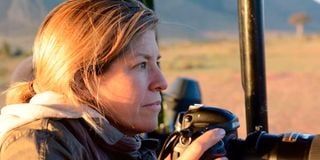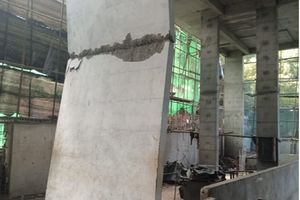Premium
Giving different perspective to war, one click at a time

War photographer Alissa Everett in Magadi in Kajiado County when she was working on a project on traditional cultures in Kenya in 2017.
For the past 20 years, Kenyan-based American war photographer Alissa Everett has been a witness to death and destruction, tragedy and triumph across the world – capturing the best and the worst of humanity under some of the most testing circumstances. The 47-year-old, who has been living in Kenya for the last six years, has seen it all.
Alissa’s choice of Nairobi was not by chance.
“I have many friends in Kenya. When I came to Kenya, I realised that it is a beautiful country and different from how it is usually portrayed. I also wanted to be close to my workplace in East Africa so that I would be able to monitor how those who escaped war are doing in the (refugee) camps. I was born and brought up in California. I realised that it was too far and that is why I decided to be based in Kenya,” said Everett.
Her passion for conflict photography has taken her to war-torn areas in Afghanistan, Gaza, Iraq, Lebanon, Liberia, Mali, Mauritania, Mozambique, Niger, Pakistan, South Sudan, Syria, Turkey, Uganda, Yemen, Darfur, the Democratic Republic of Congo, among others.
She has smelled death. She has seen the anguish, hopelessness, and gloom in the faces of women and their children on warfronts and this often fills her heart with sorrow and compels her to help.
Noted for her bravery, Alissa has watched fallen soldiers wade through the settling smog, covered with grief as their people lay down lifeless and their property completely destroyed.
She has seen big bungalows, which previously shot the sky like arrows, reduced to rubble.
She was recently in Ukraine, and she shared her experience with Lifestyle in a recent interview. She spoke of a night when the only thing that could be heard were the warplanes whizzing through the sky, moving at a rapid speed.
Alissa says it was gloom all over and that wherever one looked, one could not see any strand of beauty to cling on to.
Outside, it was silent, desolate, and bleak. There were loud sounds of bombs, and dogs barking in the distance as the sun dropped from the horizon ushering in a night of many uncertainties.
From a distance, the roar of planes mixed in with the echoes from a distant fire fight was all that could be heard in the dark.
Her passion for photography has seen her visit more than 130 countries as she attempted to capture images to document for the present and the future.
Artplugged.co.uk writes that Alissa was the only photographer allowed to take pictures at the capture of Saddam Hussein’s sons in the outskirts of Mosul in 2003.
“She was in Baghdad documenting the local reaction when Hussein himself was found,” it adds.
Unexpected positives
Thanks to photography, she has seen both the hostile and the unexpectedly positive sides of war. She has seen families separated, people who lost hope, frightened and paralysed by the adverse effects of war.
She has also seen those who were united with their families after a long search, those who lost parts of their bodies but were driven by passion and compassion.
Tired of experiencing the deadly side of war, she decided to shift her coverage and focus on the beauty found in the midst of turmoil and anguish on the battlefield.
Under a non-governmental organisation, on a recent trip to Europe she decided to camp on the border of Ukraine and Russia. She was now walking through Moldova, Poland and Romania to offer her support to the frightened and tired individuals that had escaped the ongoing war.
She wanted to be part of humanity and not just unleash photographs of dead soldiers and individuals. She wanted to drift her attention on the recovery path, the rescued ones and those who managed to escape.
She was there at the border in early March, seeing how helpless those who fled the Ukraine war were.
“The flow never stopped. Millions of refugees left Ukraine to find safety. The most affected were women and children. Some were expectant while others had various physical challenges,” said Alissa.
Poland, Romania, Hungary, Moldova, Slovakia and Belarus had taken in the highest number of refugees.
“Uncountable individuals made their way to the border. Women and children arrived and the saving unit was there to welcome them. I was part of the unit and together we helped them find temporary places to stay. They had to start making friends afresh, find a new family and assimilate new traditions and beliefs. I offered phones to some of them to help them call their families that were still trapped in the conflict zone,” says the photographer.
She offered a listening ear and a big heart to receive and assist them get into temporary housing. With her camera wrapped around her waist, she would walk into every camp to ensure that all the women and children that had survived war were alright — just to create a conducive environment that would make them free and willing to share their experiences.
She always endeavours to create the narrative that life has and must continue irrespective of any wars being fought.
Also Read: US journalist shot dead in Ukraine
In Kenya, she has covered many stories, including the impact of the closure of schools due to Covid-19. She has also documented the effects of the pandemic on women who work from home and how they were coping with the children and workload at home.
Refugee education
She has also handled wildlife issues and covered the impact of climate change on locals in Mombasa.
With a keen interest on the fate of the displaced, Alissa has participated in refugee education in Kenya, especially in Kakuma Refugee Camp and Kalobeyei Integrated Settlement in Turkana County.
Recently, she helped raise funds to build a library in Kakuma Refugee Camp that will serve thousands of refugees from Sudan, South Sudan, Somalia, the Democratic Republic of Congo, Burundi, Ethiopia and Uganda.
While in conflict situations, Alissa uses her photographs to tell stories ranging from forced migration, sexual violence and environmental consequences of fighting.
She says, “Many photographers are doing the incredibly important work of documenting the negative side of humankind. Not enough coverage is given to the moments of beauty, humanity and dignity in places defined by war.”
“While working in conflict zones, I realised that photography had an opinion. For every shocking image published of death or destruction, there were many that could be made of beauty hidden in the situation. Some of my strongest impressions in challenging locations were times when families opened their doors to me,” she says.
She covers events such as weddings, children playing, mothers delivering, families reuniting, among other “normal” activities during war.
Even in conflicting countries, people still have life and dignity. Alissa says that capturing positive stories in the midst of war helps people understand that life has to continue.
“People have to wed, pray, celebrate their special days and children have to continue with their education despite being in a new environment. Life has to continue. This is why I decided to capture the beauty in the midst of war,” says Alissa.
After the survivors settle in a given environment, she visits them and helps them overcome some of their experiences while in the conflicting area.
She gets their stories and documents them through photography.
Her excellent photography skills have been recognised by various organisations which have awarded her various excellence awards.
In 2007, Alissa founded Exposing Hope, a non-profit organisation that raised awareness about and funds for victims of human rights abuses worldwide through documentary photography.
Wide range of photos
Among photos captured by Alissa include one from 2021 at a refugee camp in Kigeme, Rwanda. She captured two women who “carried their work” to the camp as they continued tailoring.
Despite the hopelessness and losing everything, the two women did not desert their tailoring passion because of war.
Instead, they carried their skills to the new environment and are using that as a means of survival and leisure.
Another of her photos was taken in 2008 after the India-Pakistan war. She captured a photo of those who fled returning home with their families.
In 2020, she captured a photo of sisters who were now mothers in Nairobi’s Mathare slums during the Covid-19 pandemic.
Another of her photos captured a Yazidi wedding and it was printed in Hahnemuhle.
The photo shows how a family in Mosul, Iraq, celebrates a wedding despite being affected by war.
Alissa says she enjoys seeing the affected families get back to their feet and continue with their lives during and after war.
“I love using my photography skills to tell stories in a great and wonderful way and to bring people together,” she says.
She also believes that the people who document wars can bring different perspectives.
“I believe journalists can tell stories in a different way because it is just not about the wounded soldiers, the dead and the destroyed properties. It is possible to tell the world that there is ‘beauty’ even in the midst of war,” she says.





